Kerala Plus One Zoology Chapter Wise Previous Questions Chapter 5 Digestion and Absorption
Question 1.
Observe the diagram: (MARCH-2010)
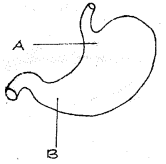
a) Label the parts A and B.
b) Even though concentrated HCl is stored in the stomach, it will not generally damage the stomach wall. Why ?
Answer:
a) A. Cardiac stomach
B. Pyloric stomach
b) Mucus and bicarbonates present in gastric juice protect the stomach wall.
Question 2.
Complete the equation by filling a1, b1, and c1.

Trypsinogen is activated to trypsin by enterokinase. How chymotrypsinogen is activated to chymotrypsin? (SAY-2010)
Answer:
a) a1) Lactase
b1) galactose
c1) glucose
b) Chymotrypsinogen is converted into chymotrypsin with the help of Trypsin
Question 3.
“The end products of fat digestion are not absorbed directly into the bloodstream’. Justify. (MARCH-2011)
Answer:
The end product of fat digestion (Fatty acids and glycerol) are insoluble in water. So they are not ab-sorbed as such into the blood.
Question 4.
Observe the given diagram and answer the following questions. (MARCH-2012)
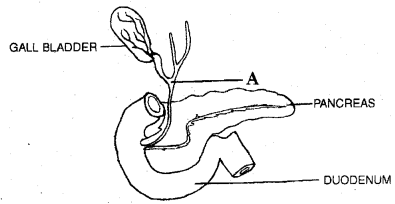
a) Identify the duct labelled A and the secretion it pours into the duodenum.
b) Mention two functions of secretion in digestion.
Answer:
a) Common bile duct
b) Emulsification of fat
Question 5.
Is it possible to compare the water vascular system of phylum Echinodermata to circulatory system of man in some aspects? Justify your answer. (SAY-2012)
Answer:
No. It is involved emulsification or the conversion of large fat into fat droplets.
Question 6.
Read the features of cell layers in the wall of human intestine. (SAY-2013)
It consists of circular and longitudinal smooth muscles.
Outer thin layer formed of mesothelium.
A layer formed of loose connective tissue and nerves.
Epithelium with goblet cells to secrete muscus. Identify the cell layers and arrange them from inside to outside as seen in the section of intestine.
Answer:
Mucosa (Innermost layer) → submucosa → Mus- cularis → Serosa (outermost)
Question 7.
Sketch an outline (or a flow chart) of protein diges¬tion taking place in your alimentary canal. (MARCH-2014)
Answer:
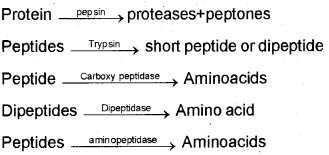
Question 8.
Identify the odd one and write the common features of the other items. (SAY-2014)
(Caecum, Colon, Rectum, Renin)
Answer:
a) Peptic or chief cells which secrete the proenzyme pepsinogen
b) The proenzyme pepsinogen, on exposure to hydrochloric acid gets converted into the active enzyme pepsin, the proteolytic enzyme of the stomach
c) peptones (peptides)
Question 9.
Pro-enzyme pepsinogen is a protein digesting enzyme (inactive form) of the human digestive system. (SAY-2014)
a) Name the digestive gland which secretes this enzyme.
b) How does pepsinogen change into its active form, pepsin?
c) Complete the following sentence:
Pepsin converts proteins into proteoses and ………….
Answer:
a) Peptic or chief cells which secrete the proenzyme pepsinogen
b) The proenzyme pepsinogen, on exposure to hydrochloric aGid gets converted into the active enzyme pepsin, the proteolytic enzyme of the stomach
c) peptones (peptides)
Question 10.
Observe the following figure. (MARCH-2015)
a) Name the figure.
b) Label the parts A, B and D
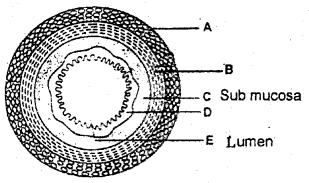
Answer:
a) Transverse section of gut
b) A-Serosa
B- Muscularis
D-Mucosa
Question 11.
Name any two secretions of exocrine glands. (SAY-2015)
Answer:
a) Trypsinogen
b) chymotrypsinogen
Question 12.
Construct a flow chart to demonstrate the digestion of proteins in different parts of human alimentary canal. (SAY-2015)
(Hint: Any three steps only)
Answer:
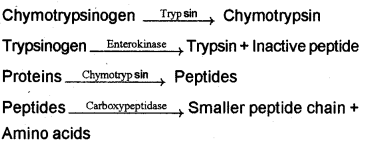
Question 13.
From the following list, pick out the enzyme, that takes part in carbohydrate digestion. (MARCH-2016)
(Salivary amylase, peptidase, lipase, carboxy peptidase)
Answer:
Salivary amylase
Question 14.
In human beings definition is ‘heterodont’. This condition means ……….(SAY-2016)
a) Presence of two types of teeth.
b) Presence of two sets of teeth.
c) Presence of different types of teeth.
d) Teeth are placed in sockets of jaw.
Answer:
c) presence of different types of teeth
Question 15.
a) Observe the given diagram and identify the parts noted as A, B and C. (SAY-2016)
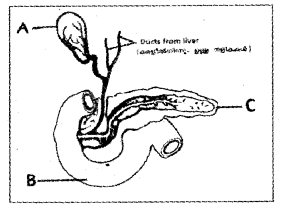
b) Write the role of secretion stored in Part A.
Answer:
a) A – Gall bladder
B – Duodenum
C – Pancreas
b) Emulsification of fat that help in fat digestion
Question 16.
Observe the diagram and label A and B. (MARCH-2017)
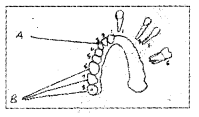
Dental formula of permanent teeth in man is
i)
ii)
iii)
iv)
Answer:
A – Canine
B – Molars
ii)
